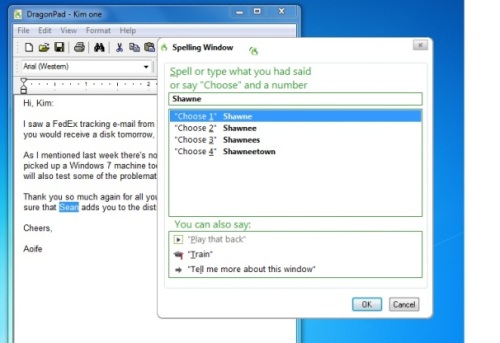Nuance has taken almost two years to roll out its new speech recognition software, Dragon NaturallySpeaking 11. Since I was impressed with the company’s previous Professional version, I was eager to don a PC headset and start yakking with the new version. In testing, I hoped to encounter exceptional improvements in accuracy and hands-free capabilities, but sadly, I did not. That’s the disappointing news.
The good news, though, is that the software’s new features get a thumbs-up; they help you use the program more effectively–ultimately, you get more stuff done.
The company says that you can get up to 99 per cent accuracy right out of the box. However, it also recommends that you train Dragon before you start using the program. This process involves reading a series of paragraphs aloud, while the software “listens” and creates your user profile. (I read an excerpt from Dogbert’s Top Secret Management Handbook by Scott Adams for about 5 minutes; other text choices are available.)
Related story
Why aren’t you using the speech recognition that comes with your computer?
19 free online services – a treat for knowledge workers
I tested Nuance’s Gold candidate–that is, its close-to-final code, which is what the company sent out for review. After the initial training, I started to dictate e-mails and reports, and after rambling on for a few thousand words, I took a tally of the average: 97.8 per cent accuracy. I continued with the training and more yakkety-yak–and accuracy climbed up to 98.3 per cent. However, akin to my experiences with Dragon NaturallySpeaking 10, I haven’t yet reached an average of 99 per cent accuracy across the board. Of course, with short e-mail messages that use informal language, as opposed to long documents, the need for editing or correction is minimal.
I talk rather quickly, and Dragon kept up with me admirably. For instance, I stumbled not once, not twice, but three times on the word “compatibility,” in separate dictation tests, and Dragon still figured out that this was the word I wanted. Bravo.
(I also tested Dragon without doing a lick of training, and its accuracy out of the box topped out at 96.3 per cent–not too shabby at all.)
Nuance has refined the interface slightly. The most notable change: The addition of the new Dragon Sidebar. I found I liked the Dragon Sidebar, which sat beside my open window and anticipated the kinds of commands or tips I needed. The content in the sidebar changes according to my active window.
Shown below is the interface’s Spelling Window.

When I use Dragon, I like to keep my hands off the keyboard as much as possible: The program works great when moving around your desktop, opening, using, and closing apps; and when searching on the Web (“search Twitter for Android”) or getting directions, for instance; but when it comes to correcting misrecognized words, I found that resorting to the keyboard–just typing the correct spelling–is far quicker, and less frustrating, than correcting by dictation.
Some of the more notable goofs: When I said “alas,” Dragon heard “a laugh.” I got “Cypress then” instead of “out for a spin,” “your blood” instead of “earbud,” and “savagery” instead of “sanitary.”
At $600, the price for Professional is steep. As an alternative, the $100 Home version offers the whole suite of Professional’s features in Word, Internet Explorer, and Firefox, but lacks full support in Excel and PowerPoint, as well as enterprise administration tools. You still get the reliable Dragon performance, though, which will keep improving–albeit incrementally–with additional training.
Pros
Accuracy is reasonably impressive with no training
Tip-oriented Dragon Sidebar works great
Cons
Expensive
Correcting misrecognized words is a hassle
Bottom Line
NaturallySpeaking software lets you dictate text and commands and bop around your PC with aplomb. The release provides great new tools, but its accuracy hasn’t improved by leaps and bounds.
Source: PCWorld




